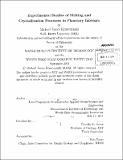| dc.contributor.advisor | Timothy L. Grove. | en_US |
| dc.contributor.author | Krawczynski, Michael James | en_US |
| dc.contributor.other | Woods Hole Oceanographic Institution. | en_US |
| dc.date.accessioned | 2012-02-29T17:57:31Z | |
| dc.date.available | 2012-02-29T17:57:31Z | |
| dc.date.copyright | 2011 | en_US |
| dc.date.issued | 2011 | en_US |
| dc.identifier.uri | http://hdl.handle.net/1721.1/69467 | |
| dc.description | Thesis (Ph. D.)--Joint Program in Oceanography/Applied Ocean Science and Engineering (Massachusetts Institute of Technology, Dept. of Earth, Atmospheric, and Planetary Sciences; and the Woods Hole Oceanographic Institution), 2011. | en_US |
| dc.description | Cataloged from PDF version of thesis. | en_US |
| dc.description | Includes bibliographical references (p. 191-202). | en_US |
| dc.description.abstract | Melting and crystallization processes on the Earth and Moon are explored in this thesis, and the topics of melt generation, transport, and crystallization are discussed in three distinct geologic environments: the Moon's mantle, the Greenland ice sheet, and the Earth's crust. Experiments have been conducted to determine the conditions of origin for two high-titanium magmas from the Moon. The lunar experiments (Chapter 2) were designed to explore the effects of variable oxygen fugacity (fo₂) on the high pressure and high temperature crystallization of olivine and orthopyroxene in high-Ti magmas. The results of these experiments showed that the source regions for the high-Ti lunar magmas are distributed both laterally and vertically within the lunar mantle, and that it is critical to estimate the pre-eruptive oxygen fugacity in order to determine true depth of origin for these magmas within the lunar mantle. Chapter 3 models the behavior of water flow through the Greenland ice sheet driven by hydrofracture of water through ice. The results show that melt water in the ablation zone of Greenland has almost immediate access to the base of the ice sheet in areas with up two kilometers of ice. Chapter 4 is an experimental study of two hydrous high-silica mantle melts from the Mt. Shasta, CA region. Crystallization is simulated at H₂O saturated conditions at all crustal depths, and a new geobarometer-hygrometer based on amphibole magnesium number is calibrated. In Chapter 5 I use the new barometer to study a suite of mafic enclaves from the Mt. Shasta region, and apply it to amphiboles in these enclaves. Evidence for pre-eruptive H₂O contents of up to 14 wt% is presented, and bulk chemical analyses of the inclusions are used to show that extensive magma mixing has occurred at all crustal depths up to 35 km beneath Mt. Shasta. | en_US |
| dc.description.statementofresponsibility | by Michael James Krawczynski. | en_US |
| dc.format.extent | 202 p. | en_US |
| dc.language.iso | eng | en_US |
| dc.publisher | Massachusetts Institute of Technology | en_US |
| dc.rights | M.I.T. theses are protected by
copyright. They may be viewed from this source for any purpose, but
reproduction or distribution in any format is prohibited without written
permission. See provided URL for inquiries about permission. | en_US |
| dc.rights.uri | http://dspace.mit.edu/handle/1721.1/7582 | en_US |
| dc.subject | Joint Program in Oceanography/Applied Ocean Science and Engineering. | en_US |
| dc.subject | Earth, Atmospheric, and Planetary Sciences. | en_US |
| dc.subject | Woods Hole Oceanographic Institution. | en_US |
| dc.subject.lcsh | Crystallization, Water of | en_US |
| dc.subject.lcsh | Magmas | en_US |
| dc.title | Experimental studies of melting and crystallization processes in planetary interiors | en_US |
| dc.type | Thesis | en_US |
| dc.description.degree | Ph.D. | en_US |
| dc.contributor.department | Joint Program in Oceanography/Applied Ocean Science and Engineering | en_US |
| dc.contributor.department | Woods Hole Oceanographic Institution | en_US |
| dc.contributor.department | Massachusetts Institute of Technology. Department of Earth, Atmospheric, and Planetary Sciences | |
| dc.identifier.oclc | 775348151 | en_US |
